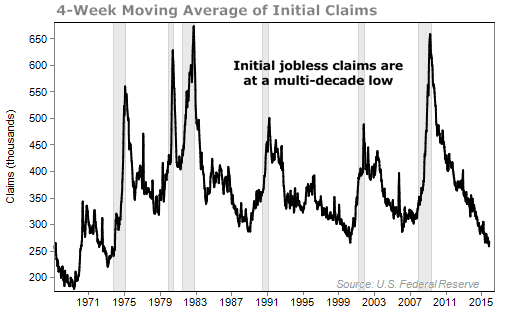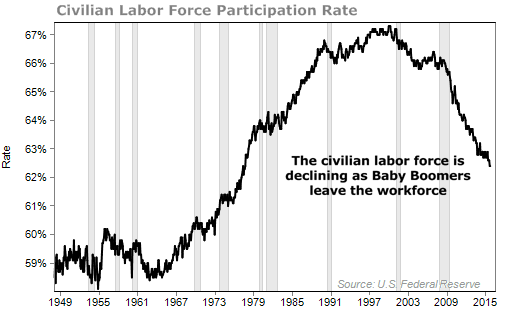The American economy is getting better... Jobs are easier to find... And household incomes are growing in most states across the country...
But many folks just won't believe it.
Take John A., for example, who wrote in to us:
Yippee! The American economy added 271,000 jobs last month. Ooops! 1,050,000 Americans filed for first-time unemployment last month.
Doesn't that mean they lost their jobs? And a similar ratio of jobs added to jobs lost has been going on for years, not just months. So how can the unemployment rate be going down?
I've got an answer for you, John. How the various employment numbers are reported can be confusing. And the talking heads will use it to frighten you or make up a story to sell their "rags."
Here's how to look at employment and the U.S. economy...
The Gold Standard of Jobs
Each month, the U.S. Bureau of Labor Statistics releases what's called the nonfarm payroll. That's the 271,000 jobs added we cited.
It surveys about 143,000 businesses and government agencies... and is widely recognized as the most comprehensive employment report in America. It's the "gold standard" of sorts.
A rule of thumb is that 250,000 jobs added in a month indicates sustainable employment growth in the economy.
Just look at how employment is growing in the chart below (recessions in gray):
In September, 142.4 million employees were the nonfarm payroll. In October, that number climbed to 142.7 million – that's where the difference of 270,000 folks comes from.
During the collapse of 2008 and 2009, the U.S. economy lost 8.6 million jobs. In February 2010, the nonfarm payroll hit a low of 129.6 million employees. It has bounced back since then and reports 13 million new employees
But it's important to realize that who's on the payroll isn't directly related to the number of people filing for unemployment.
[optin_form id="73"]
How to Measure Firings
If one company lays off 10 people, but another company hires 12 people who didn't already have a job, you'll have an extra two nonfarm payroll jobs in the economy... even though 10 people could apply for unemployment benefits.
If they did, they'd show up on what's known as initial jobless claims – the number of people who get fired or laid off each week.
This is the 1.05 million figure in October that you pointed out to us, John... The statistic for the month combines the weekly numbers from the U.S. Department of Labor that month. This is the number of folks who have lost their jobs and are filing for unemployment benefits that week.
However, because the one-week number is volatile and regularly revised up or down, most economists use the four-week moving average of jobless claims.
Here's what it looks like in a historical context...
And when you look at the monthly numbers, voila, as you can see, we're at the lowest level since the mid-'70s.
Take the two statistics – the number of folks on the payrolls, and the number of folks filing for unemployment – and you've got positive news.
Of course, these numbers are not perfect, and the Chicken Littles who see the sky falling like to talk about all the folks who...
Give Up and Drop Out
In fact, we got an e-mail from Jim C. on this topic, who wrote:
I don't understand how you can get so excited about the jobs report when the labor participation rate is so low. 94 million adult Americans not working cannot be good news.
It's a great question. But to be clear, I don't want all of those 94 million Americans working. A lot of retirees in that group have no interest in going back to work.
That begs the question: How many people have given up on finding a job and are completely out of the labor force?
And I confess, the labor participation rate that Jim cites is the one major employment number that hasn't improved since the latest recession ended.
According to the labor participation rate, only 62.4% of Americans are considered part of the civilian labor force – meaning they're either employed or actively looking for work. So yes, around 94 million Americans aren't working.
However, this number still includes 46 million folks who are aged 60 and older...
The Congressional Budget Office (CBO) estimates that roughly half of the three-percentage-point decline in labor-force participation since the end of 2007 is due to the aging of the workforce. It's also likely to keep declining for at least the next several years as Baby Boomers continue to age out of the workforce...
Add that 3% back in and you get back up to levels of the 1990s. Not at our peak, but far above where the participation rate was for almost 40 years (1950s through 1980s).
Of course, it still means several million Americans have been "left out" of our latest recovery. For them, the economy doesn't look all that great. But given where we've been over the past 70 years, things look good.
What We're Reading
- Exploring the Iowa paradox: The economy is better, so why don't voters believe it?
- About 42% of Americans are unemployed (if you include my 88-year-old grandma).
- Something different: Flamboyant food personality Guy Fieri is making wine.



